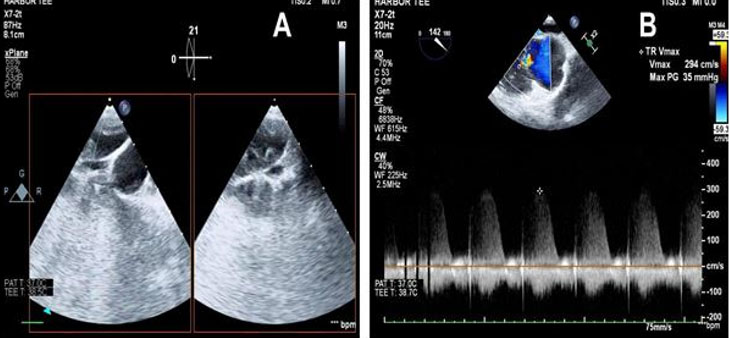 |
Clinical Image
Deep vein thrombosis of the upper limb
1 Internal Medicine Resident, Department of Internal Medicine, Unidade Local de Saúde de Braga, Braga, Portugal; Invited Assistant, School of Medicine, University of Minho, Braga, Portugal
2 Internal Medicine Resident, Department of Internal Medicine, Unidade Local de Saúde de Braga, Braga, Portugal
3 Internal Medicine Physician, Department of Internal Medicine, Unidade Local de Saúde de Braga, Braga, Portugal
Address correspondence to:
Rui Jorge Sousa da Silva
Sete Fontes - São Victor, 4710-243 Braga,
Portugal
Message to Corresponding Author
Article ID: 100079Z09RS2025
Access full text article on other devices

Access PDF of article on other devices

How to cite this article
da Silva RJS, Antunes E, Silva I, Caridade S. Deep vein thrombosis of the upper limb. J Case Rep Images Med 2025;11(1):5–7.ABSTRACT
No Abstract
Keywords: Anticoagulation therapy, Breast cancer complications, Subclavian vein occlusion, Upper extremity deep vein thrombosis
Case Report
An 83-year-old woman with a history of right breast cancer was hospitalized for the diagnostic workup of a lytic lesion. She previously underwent mastectomy, radiotherapy, and chemotherapy for the tumor. On the sixth day of hospitalization, she presented blanchable erythema on the right upper limb (Figure 1). The limb had a strong pulse, with no other abnormalities noted on physical examination. There was no history of recent manipulation of the limb. A contrasted computed tomography (CT) scan showed maintained patency of the subclavian vein but with filiform filling. As skin color progressively worsened with wine discoloration and the limb started presenting edema (Figure 2), a Doppler ultrasound was performed, revealing acute, occlusive subclavian vein thrombosis. Anticoagulation with low molecular weight heparin was started, and the patient showed progressive improvement. One and a half weeks after the start of the therapy, edema resolved, and the skin discoloration improved (Figure 3).
Discussion
Only about 10% of deep vein thromboses involve the upper limb [1]. Central venous catheterization, malignancy, radiotherapy, and chemotherapy are risk factors for this condition [2]. This patient presented a secondary form of deep vein thrombosis, characterized by exuberant skin color manifestations, as shown in the images. Appropriate anticoagulation therapy led to improvement in her condition, with progressive normalization of the skin discoloration.
Conclusion
This case highlights a rare and exuberant form of upper extremity deep vein thrombosis. The patient’s rapid response to anticoagulation therapy underscores the effectiveness of this treatment in managing the condition, preventing further complications, and improving clinical outcomes.
REFERENCES
1.
Duijzer D, de Winter MA, Nijkeuter M, Tuinenburg AE, Westerink J. Upper extremity deep vein thrombosis and asymptomatic vein occlusion in patients with transvenous leads: A systematic review and meta-analysis. Front Cardiovasc Med 2021;8:698336. [CrossRef]
[Pubmed]

2.
Grigorian A, Nahmias JT. Upper Extremity Deep Venous Thrombosis. In: StatPearls. Treasure Island (FL): StatPearls Publishing; 2025.
[Pubmed]

SUPPORTING INFORMATION
Author Contributions
Rui Jorge Sousa da Silva - Conception of the work, Design of the work, Drafting the work, Revising the work critically for important intellectual content, Final approval of the version to be published, Agree to be accountable for all aspects of the work in ensuring that questions related to the accuracy or integrity of any part of the work are appropriately investigated and resolved.
Eulália Antunes - Conception of the work, Design of the work, Acquisition of data, Drafting the work, Revising the work critically for important intellectual content, Final approval of the version to be published, Agree to be accountable for all aspects of the work in ensuring that questions related to the accuracy or integrity of any part of the work are appropriately investigated and resolved.
Isabel Silva - Conception of the work, Design of the work, Revising the work critically for important intellectual content, Final approval of the version to be published, Agree to be accountable for all aspects of the work in ensuring that questions related to the accuracy or integrity of any part of the work are appropriately investigated and resolved.
Sofia Caridade - Conception of the work, Design of the work, Revising the work critically for important intellectual content, Final approval of the version to be published, Agree to be accountable for all aspects of the work in ensuring that questions related to the accuracy or integrity of any part of the work are appropriately investigated and resolved.
Guaranter of SubmissionThe corresponding author is the guarantor of submission.
Source of SupportNone
Consent StatementWritten informed consent was obtained from the patient for publication of this article.
Data AvailabilityAll relevant data are within the paper and its Supporting Information files.
Conflict of InterestAuthors declare no conflict of interest.
Copyright© 2025 Rui Jorge Sousa da Silva et al. This article is distributed under the terms of Creative Commons Attribution License which permits unrestricted use, distribution and reproduction in any medium provided the original author(s) and original publisher are properly credited. Please see the copyright policy on the journal website for more information.








